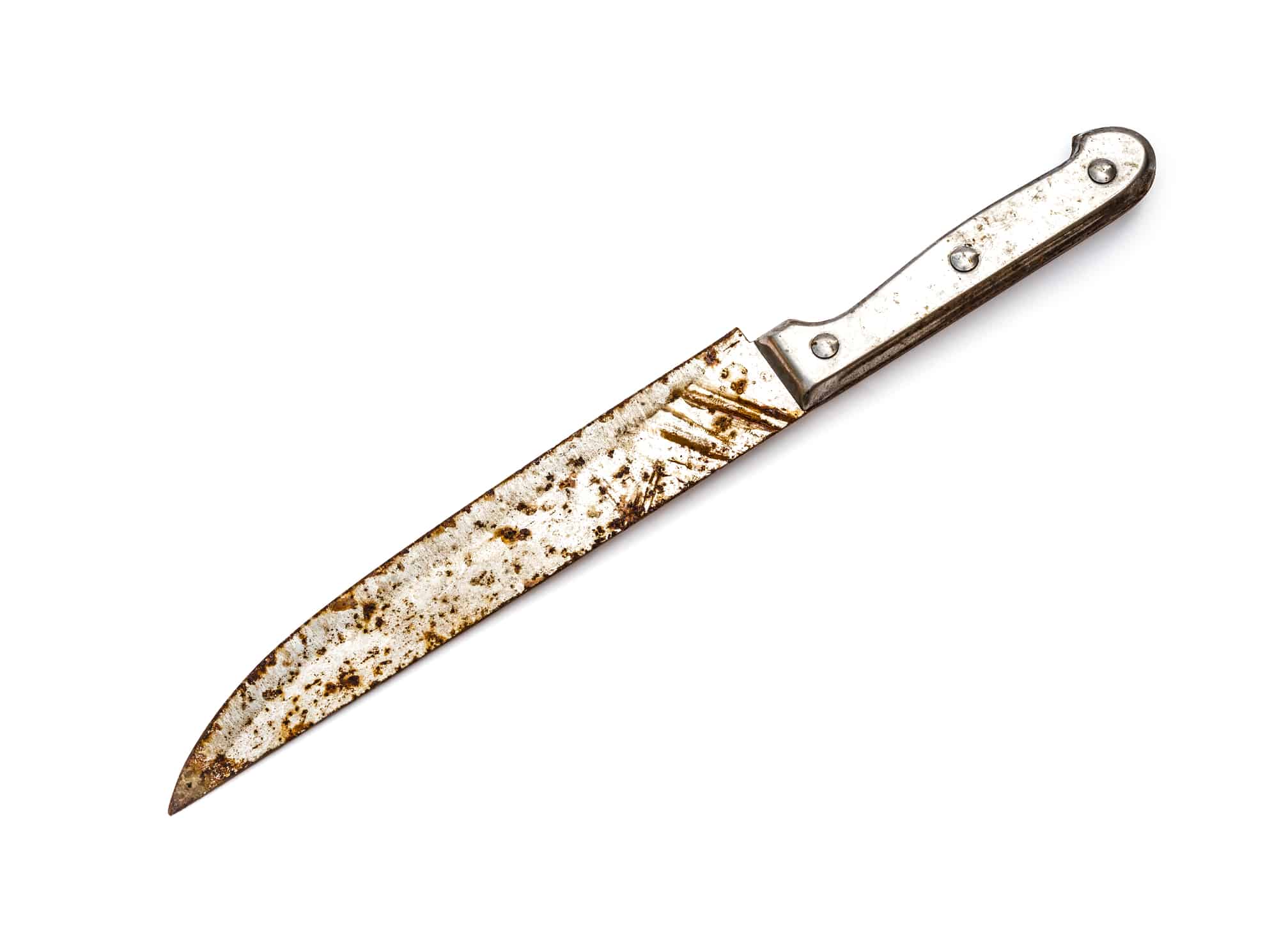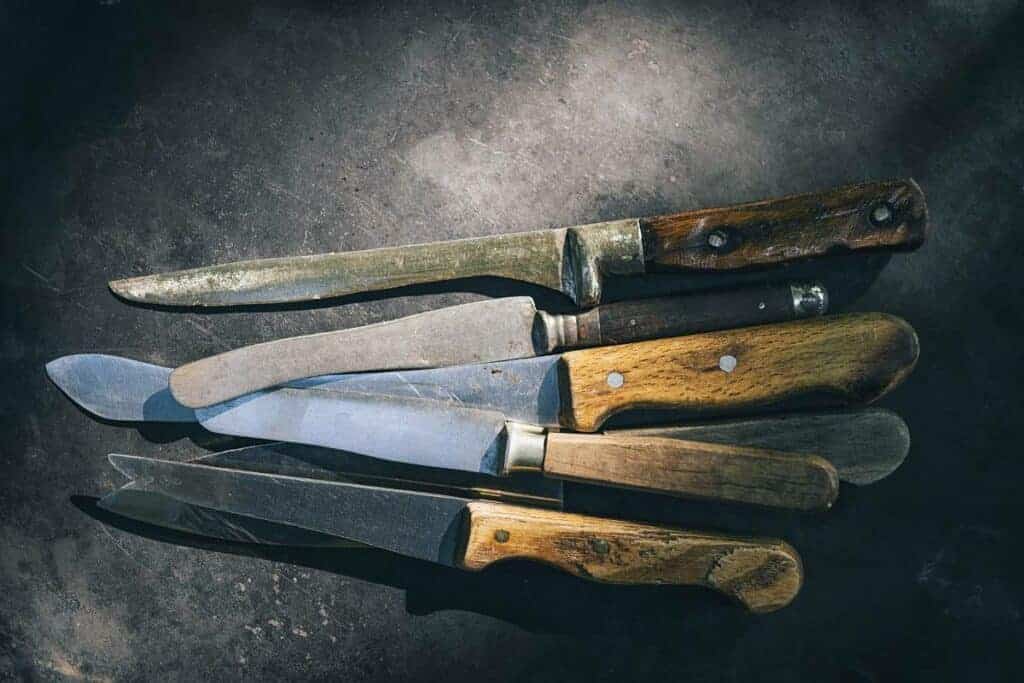This post contains affiliate links. As an Amazon Associate I earn from qualifying purchases
Table of Contents
Remove Rust From Kitchen Knives
Are your kitchen knives starting to rust? We have the simple and effective solutions to your problem and, more importantly, we show you how to stop this happening again.
There is perhaps nothing more frustrating than pulling out your favorite knife while cooking and seeing that it has started to rust. Obviously, nobody wants the taste of metal in their food, so cooking with a rusty knife is a no-go.
However, rust is not the end of the road for your knives – they can still be saved. Once you have got the hang of removing rust from your knives, you will have them looking as good as new in no time. So let’s take a look at what you can do.
Removing Rust
Here are a few things you can do to rid your kitchen knives of pesky rust and corrosion.
Vinegar
This is probably the most common method to remove rust from kitchen knives, and it is definitely the simplest. All you need to do is soak the knife in enough white vinegar to submerge the entire blade for 30 minutes.
Once the time is up, remove the knife from the vinegar and gently scrub the rust away with a scrubbing pad. You may need to soak the knife for longer, depending on the severity of the corrosion.
Lemon Juice
Another simple rust solution, the acidity in lemon juice is usually strong enough to melt away any rust that may have formed on your knives. Slice a lemon in half and run the exposed inside along the blade.
If the rust is quite moderate, you should be able to gently scrub the rust away using a scrubbing pad. If it is quite stubborn, you may need to leave the lemon on the rusted area for about 30 minutes or until the rust starts falling off.
Baking Soda
This is a less popular method, but it is still very simple. Start by creating a sort of paste by mixing 3 teaspoons of baking soda with 1/2 a teaspoon of water.
Stir the water and baking soda until they form a paste, then apply the paste to the blade liberally using a toothbrush. If the rust is not too severe, you can begin gently scrubbing it away.
For blades with advanced rust, you will need some more abrasion to remove the corrosion. Steel wool is a great tool for this, though be careful not to scrub too hard, or you might scratch and chip your blade.
Lastly, clean the blade off using a piece of cloth to remove any excess baking powder paste that may be left behind. If you are truly dedicated to your knives, you could apply a bit of mineral oil once the blade is dry so that it is lubricated and protected.
A Potato
A popular and simple method is to simply put the blade of the knife into a large potato. Let it stay inserted for a few hours, maybe overnight, remove and wipe clean (wiping with some oil works best). It’s the old Oxalic Acid that does the trick.
Preventing Rust On Your Knife
There are a number of simple things you can do to prevent your knives from ever rusting. Here are some of them.
Avoid washing your knives in the dishwasher
Dishwashers work by dousing your dishes in hot, soapy water, then rinsing them in cool water. The fluctuation in temperature will cause the blades of your knives to warp, which will form weak spots that rust will cling to.
Instead, wash your knives by hand using mild, non-acidic dish soap or detergent. Do so in lukewarm water, and rinse the knives in cooler water.
Avoid salty water
Salt can encourage rust buildup on the blades of knives made from materials like carbon fiber. If you plan to work in an environment where there is a lot of saltwater present, use ceramic or titanium knives instead.
Dry your knives after washing them
As you probably know, rust is caused by a chemical reaction known as oxidation. This is the process in which oxygen atoms found in water molecules bond with iron, which creates a by-product that we know as rust. Always dry your knives after use so this process can’t happen.
Caring For Your Kitchen Knives
Treating your kitchen knives with as much care as you would a child is crucial since they are one of the most fundamental kitchen utensils out there. Regardless of how sharp the blade is, knives are fragile and can be damaged easily.
Here are some things you can do to keep your knives in top shape.
Don’t store your knives in your utensil drawer
Tossing your knives in any drawer with your other utensils is one of the worst things you can do. It is so easy for the blades to become scratched and dented from being moved around in the drawer each time you open it.
If you have nowhere else to store your knives, use a sheath. Not only is this good for the knives, but it makes it easy to find them each time you need to use them.
Don’t leave your knives in the kitchen sink
This is quite a dangerous way to mishandle your knives, as the blade can become scratched. Also, the tip could get bent, or the knives could cut anyone who goes to use the sink. Instead, as soon as you have washed your knives, dry them and store them in a safe place.
Don’t leave your knives out to dry
When you leave your knives out on the dish rack to dry, you are risking dulling the blade, especially when it shares a space with other utensils. Dry your knife immediately after it has been washed so that no corrosion forms. Then, pack it away in a safe place.
Cut on cutting boards only
While it is tempting to cut on your countertop, avoid doing so at all costs. Solid surfaces like granite and marble are far too hard for the blade and will dull and damage it.
Instead, use wooden chopping boards with your knives. They are soft enough to prevent damage to the blade, while still being firm enough to provide a sturdy surface. Marble cutting boards look nice but are not the greatest for your knife.
Wrapping Up
It is clear to see just how important it is to remove rust from kitchen knives and how equally important it is to prevent rust from forming again. Regardless of its purpose, a rusty knife will never do any good. The good news is that all the above cleaning methods are easy and cost very little.
As the number of cheaper knives coming on to the market has increased, the rust issue is more common. Where the blade meets the handle is also a problem, causing the blade to snap off. If the problem of rusting persists, maybe you should think of buying a better quality knife.
We hope that this guide has made removing and preventing rust a little easier!


